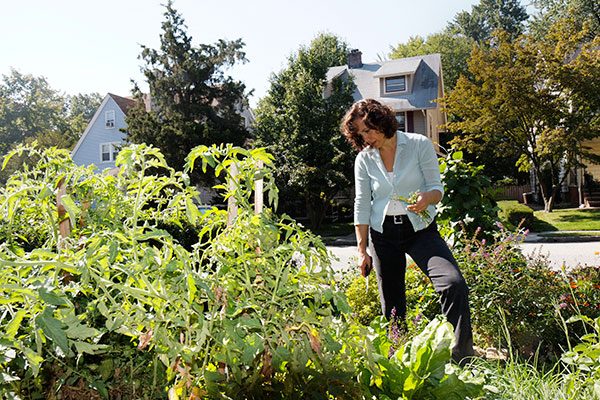
It was a normal vegetable garden in every respect but one—it was in front of the house.
A front-yard garden is, by definition, in your face. (In your neighbors’ faces, in particular.) Sunflowers towering, tomato plants climbing, cabbages blooming, beans and basil proliferating like weeds. All growing naked for anyone to see—and, as my sister worried, for dogs to tear through. (Thankfully, they never did.)
Actually, ours was unusual in another respect as well. It was built on friendship. My husband and our two sons live in a condo that is one side of a big old house. Last year, my friend Arielle and her husband, David, bought the unit on the other side.
They were expecting a baby and moving back East after a long stint in California. So one winter afternoon, not long after the move had been made and the baby had been born, we new neighbors began conjuring images of Eden in our yard. Each of us, including the kids, suggested crops we’d like to eat.
As the list grew longer—green beans, spinach, potatoes, peppers, chard—it became clear the project would require a great deal of energy from us and from the radiant orb in the sky. Which answers the question: Why the front yard? Because that’s where we get the full sun.
But it wasn’t only about sun. It was a stand against the worshipped velvet known as lawn—an institution that seems, to our minds, more and more useless. It has to be mowed weekly (what a pain) with a machine that consumes fossil fuels and spews exhaust and noise. It has to be fed with chemicals that pollute.
Need I go on?
Now it’s fall and we’re just about done. As the cucumber plants shrivel and the weakening sun fails to turn the last tomatoes red, we revel in our harvest: red chili peppers hanging upside down in the kitchen near my son’s carrots, dug after the first frost; jars of pesto and tomato sauce stacked in the basement freezer; beans dried in the pod; and lots of plastic bags sealed tight with herbs to last us through the winter.
I suppose we’re part of the edible landscape movement I’ve been hearing about. Seed sales are up nationally. And more people want to tear up grass and plant food.
But for me it was no such trend. Having spent some time in Liguria, Italy, I observed—whether in remote mountain villages or seaside towns—that fruits, flowers, and vegetables are such a beloved part of life there that they get prime real estate in the front yard, in beautiful arrangements living in peaceful coexistence. Why do we relegate them to the back yard here?
Of course, the reality of compacted New Jersey clay is another matter. You have no idea how deep the lawn roots go until you spend a couple of weekends trying to break them, using your shovel as a machete, digging and thrusting. Your body aches for many days, and you feel as though you’ve been in a car accident. So we bought into the classic solution: Build raised beds, 6 inches above the ground, filled with nice new workable soil.
But the prefab beds you snap together from wood—well, they didn’t fit in with our quest for front-yard beauty. We wondered if we could possibly build stone enclosures. Arielle and I headed off to various stone yards, and she convinced me that we needed to find the right colored stone to match our house—a palate of red brick and yellow shingle.
After much searching, we found a gray rock with strong yellowish and red hues—the perfect color. We believed ourselves brilliant. A truck arrived and unloaded several tons of “sunset” on our front walk. Alas, it didn’t take long to notice that many of our stones were not stones at all but giant boulders.
Now, some people in this life get discouraged, while others simply ask for a sledgehammer. David is the latter. This is why it’s a gazillion times better to do hard projects with a team. Soon David was grunting, sweating, and breaking rocks. We got another sledgehammer, and my husband joined in the cathartic testosterone fest.
Neighbors can get pretty angry about such things as growing food in full frontal view and piling rocks on the sidewalks. But ours did not complain. Rather, they peeked out their front doors, first with curiosity, then awe, then pity.
Some came by to offer advice. Others lent us tools. “It’s like the chain gang,” one noted. We played the Pretenders’ “Back on the Chain Gang” out the window to make the job go faster. It didn’t. People slowed their cars to watch the spectacle. All this went on in 90-degree heat in mid-May.
“It’s not worth it,” my 12-year-old moaned, tired of bagging sod.
Was he right? Was it all folly? We had never done this. Could we pull it off? It took a couple of back-breaking weeks, but finally the walls were built, the beds filled. We breathed. Then we stepped across the street to have a look. We feared we’d see a jumble of mismatched stone and crooked walls. But we gasped with pleasure.
“Oh my gosh,” Arielle said. “It looks amazing.”
Soon the seeds and seedlings went into the earth. “I can’t believe you actually did it,” my oldest noted as he plunked down a scraggly little tomato seedling he had started in science class.
The enterprise took off with almost eerie force. First bushy leaves and vines; then blossoms; then fruits. By mid-July, the Early Girl tomatoes were turning red at my front door. I told a gardener friend about our plot and all the joy and pleasure it brought. She smiled knowingly. “That’s what gardens do.”
What we didn’t expect was that the front yard would become our little public square, a hangout for children, pets, and neighbors. We put out chairs and sat for a bit almost each day. People on the block came by and talked to us. Local kids asked a lot of gardening questions while plucking beans and eating them on the spot.
When school resumed, my son brought his science teacher a juicy red tomato from the plant he’d started from seeds she’d given him. “This has never happened before,” she said, with some disbelief.
Of course, we made mistakes. There was the “gugutz,” a Sicilian zucchini that sent out 20 feet of vine and nearly snatched up and ate my children, it grew so fast. We learned that picking and cooking can be harder than planting.
But the great thing about a garden is that it gets better each year as you gain experience. Gardens also create a unique kind of optimism, because you can actually see and hold and taste the results.
When the unavoidable gray of February comes, I’ll make myself tea from the verbena I grew and envision a cherry or apricot tree, because now I am confident we will root it in a good spot. We’re already creating compost to enrich and strengthen the soil. Come spring we’ll bust more sod, because for sure we want to expand the edible landscape—and mow even less lawn.
Contributing writer Laura Schenone blogs at jellypress.com and is the author this year of The Lost Ravioli Recipes of Hoboken.
